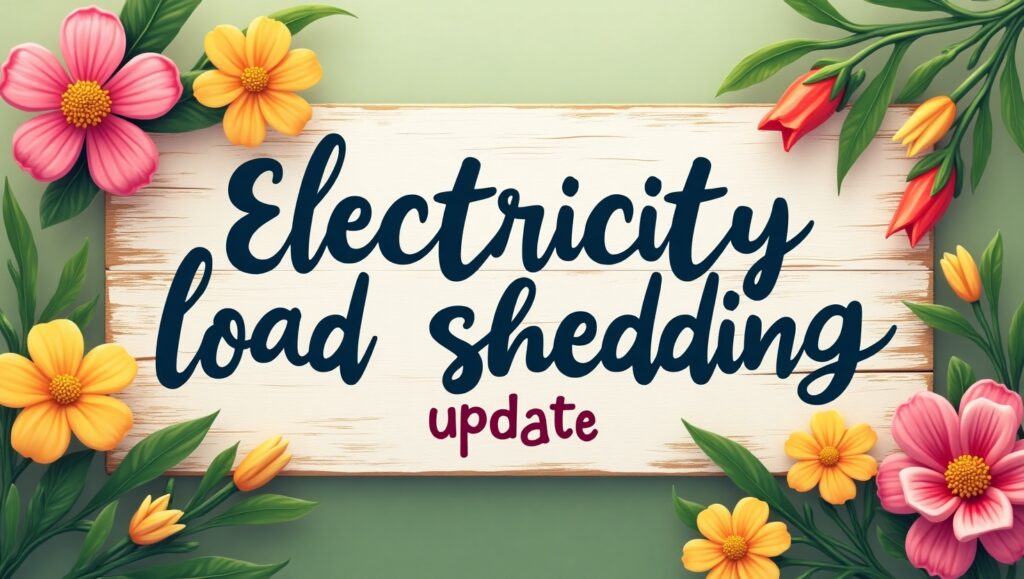⚡Electricity Load Shedding Update: Pakistan’s Current Snapshot – July 2025 1. 🏙️ Karachi & K-Electric: Theft & Billing Woes
Karachi Electric (K-Electric) CEO Moonis Alvi warned that power shortages will endure until all users complete their debts. Nearly 30% of feeders are impacted by illegal connections (“kunda”) and unpaid dues, resulting to targeted load shedding in particular zones—all while 70% of feeders remain free from load decrease
IESCO +13 The Express Tribune +13 YouTube +13 .
This uneven distribution fuels public frustration—demonstrated by protests and the Samaa TV report highlighting 14-hour daily blackouts disrupting livelihoods YouTube .
National Heatwave = Extended Outages
The Nation’s July 9 editorial highlights how continuous heatwaves across Pakistan have led to load shedding surpassing 12 hours daily, affecting homes, businesses, healthcare, and education
loadshedding.com
+2
The Nation +2
The Nation +2 . Despite sufficient installed capacity—46,605 MW, potentially exceeding demand—inefficiencies in transmission, distribution, and generation result in a prolonged crisis
Dawn +1 Wikipedia +1 .- 💸 Circular Debt & Political Accountability
A recent Senate Standing Committee hearing criticized ongoing load shedding despite available power. The committee revealed that circular debt has ballooned due to inflated IPP contracts and lack of recovery, shifting financial burden onto consumers Dawn . Officials stated that disruptions are usually in zones with heavy theft, while programs like digital meter readings (500,000 downloads so far) attempt to increase transparency Dawn .
Distribution Company Shutdowns & Maintenance
Utilities like IESCO and PESCO have scheduled maintenance shutdowns across coverage areas: IESCO has announced monthly shutdowns across Islamabad, Rawalpindi, Attock, and Chakwal for July. While these are routine, they aggravate current load-shedding patterns
The Nation +6 IESCO +6 IESCO +6 . PESCO also conducts regular scheduled shutdowns, presumably for upkeep and upgrades Wikipedia . These scheduled interruptions add to unpredictability, despite being meant for long-term system improvements.
Solar Boom: A Double-Edged Sword
Pakistan’s rise of solar energy is impressive: 5.3 GW net-metering capacity, with solar now contributing for ~25% of total generation Wikipedia . However, lack of integration with the national grid means significant solar capacity remains off-grid. This cuts demand, pushing thermal plants idle while still collecting capacity payments—driving up circular debt Dawn .
What’s Causing the Crisis?
Key elements fueling sustained load shedding: Electricity Theft & Non-payment
Illegal connections (kunda) and bill evasion contribute to large losses and targeted outages
Dawn +6
YouTube +6
TikTok +6
The Nation +3
Wikipedia +3
Dawn +3
Wikipedia +2
The Express Tribune +2
The Nation +2 . Infrastructure Decay
Transmission losses of ~25–30% and old equipment require power disruptions The Nation Dawn . Circular Debt & Financial Imbalance
With IPP contracts and debt servicing consuming national resources, utilities can’t sustainably purchase or distribute power efficiently
YouTube +14 Dawn +14 Dawn +14 . Mismatch between Capacity and Demand
Despite a total capacity of 46,605 MW, only roughly 10,290 MW was utilized—reflecting low productive demand and increased renewable consumption
Wikipedia +8
Dawn +8
The Express Tribune +8 .
Government Efforts & Policy Proposals
Legalizing “Recovery-Based” Load Shedding
The PMO is considering formalizing power cuts in recovery-defined areas—areas where losses and inefficiencies are high—by drafting legal frameworks
Profit by Pakistan Today . However, policy continues contested by NEPRA and the Finance Ministry, citing unproven economic reasoning and worries over increasing consumer burden
Profit by Pakistan Today
+1 Dawn +1 . Anti-Theft Technology K-Electric and others are deploying aerial bundled cables (ABC) and transformer-level theft detection, but enforcement remains inconsistent, especially in informal settlements
Dawn +4
Wikipedia +4 Dawn +4 . Metering & Consumer Tools
Enhanced digital meter reading via mobile apps and consumer registration aims to improve accountability; however, adoption remains partial Dawn .
Impact on Citizens & Businesses Homes:
- Lack of fans and water pumps in peak summer affect health and well-being. Healthcare: Patients depending on power for medical equipment face life-threatening risks. Education & Commerce: Classrooms lack power; businesses lose production. Regional Inequity: Some areas (especially in Sindh, Punjab, K-P) suffer longer, unannounced outages while more affluent zones receive preference.
- ✅ Recommendations for Solutions Reform theft and payment enforcement: Prioritize enforcement on unlawful connections and incentivise fast payments. Modernize infrastructure: Invest in smart grids, AI-based loss detection, and transmission enhancements. Integration of renewables: Fully integrate solar into the national grid to reduce surplus capacity fees. Transparent policies: Publish load-shedding schedules and keep regulatory checks on IPP contracts. Demand stimulation: Promote energy-intensive industries—like data centers and EV charging—to utilize excess capacity profitably.
Conclusion
Pakistan remains locked in a power struggle despite having considerable generation capacity. The complicated mix of theft, debt, infrastructure decline, renewable deployment, and legislative delay has left populations experiencing protracted daily blackouts. Real improvement requires coordinated action—tackling theft, modernizing grids, legal clarity around load shedding, and aligning energy supply with real demand. Until then, homes and businesses will face the weight of electrical unpredictability.

